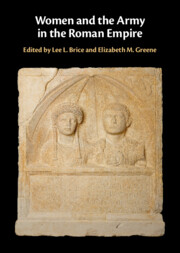Book contents
- Women and the Army in the Roman Empire
- Women and the Army in the Roman Empire
- Copyright page
- Dedication
- Contents
- Figures
- Maps
- Tables
- Contributors
- Acknowledgments
- Abbreviations
- Maps
- 1 Present but not Accounted For
- 2 Approaches to Women and the Roman Army
- 3 Agrippina and Company
- 4 Elite Marriage and Adultery in the Camp
- 5 Mother Courage and Her Children
- 6 Investigating Roles for Women inside Roman Military Bases through Artifact Distribution
- 7 (In)Visible Women and Children
- 8 Soldiers’ Wives en Route in Roman Egypt
- 9 The Role of Women in the Religious Activities of Roman Military Communities
- 10 Mater Castrorum
- 11 Women and the Military in the Age of Justinian
- Index
- References
6 - Investigating Roles for Women inside Roman Military Bases through Artifact Distribution
Published online by Cambridge University Press: 24 October 2024
- Women and the Army in the Roman Empire
- Women and the Army in the Roman Empire
- Copyright page
- Dedication
- Contents
- Figures
- Maps
- Tables
- Contributors
- Acknowledgments
- Abbreviations
- Maps
- 1 Present but not Accounted For
- 2 Approaches to Women and the Roman Army
- 3 Agrippina and Company
- 4 Elite Marriage and Adultery in the Camp
- 5 Mother Courage and Her Children
- 6 Investigating Roles for Women inside Roman Military Bases through Artifact Distribution
- 7 (In)Visible Women and Children
- 8 Soldiers’ Wives en Route in Roman Egypt
- 9 The Role of Women in the Religious Activities of Roman Military Communities
- 10 Mater Castrorum
- 11 Women and the Military in the Age of Justinian
- Index
- References
Summary
Recent research is demonstrating that other women and children, besides those in senior officers’ families, lived inside Roman military bases during the Principate; however, such women are rarely discussed in written sources. Also, the archaeological remains of military bases essentially lack the types of evidence for sexed bodies and gendered practices that can be found in burial contexts and figurative representations. This chapter discusses how more material-cultural approaches to artifactual remains from such sites can be used to investigate gendered identities and lived socio-spatial practices, and to develop better understanding of the place of such women in these hypermasculine spaces. This chapter is concerned with developing approaches to the artifactual remains from these sites, and the potential range of people and activities they represent, to investigate the presence of women within the fortification walls of these bases, and the roles that they may have played here. It demonstrates how an integrated approach to “gendering” artifacts can be used to explore the probabilities, rather than the certainties, of artifacts as gender attributes and how analyses of artifact distribution patterns can be used to identify women who often are not identified through other media, and so seeks solutions to identifying gendered behaviors.
- Type
- Chapter
- Information
- Women and the Army in the Roman Empire , pp. 151 - 180Publisher: Cambridge University PressPrint publication year: 2024

